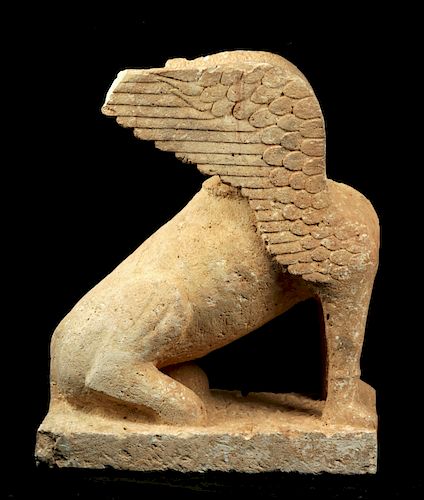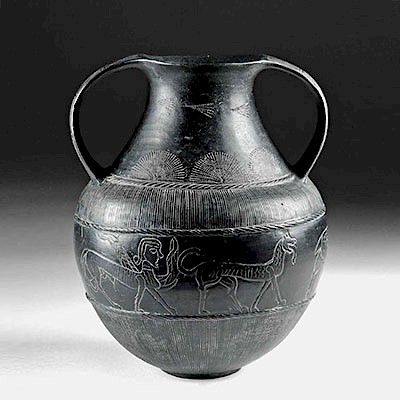Monumental Archaic Greek Limestone Statue of a Sphinx
Lot 22b
About Seller
Artemis Fine Arts
686 S Taylor Ave, Ste 106
Louisville, CO 80027
United States
Selling antiquities, ancient and ethnographic art online since 1993, Artemis Gallery specializes in Classical Antiquities (Egyptian, Greek, Roman, Near Eastern), Asian, Pre-Columbian, African / Tribal / Oceanographic art. Our extensive inventory includes pottery, stone, metal, wood, glass and textil...Read more
Estimate:
$60,000 - $90,000
Absentee vs Live bid
Two ways to bid:
- Leave a max absentee bid and the platform will bid on your behalf up to your maximum bid during the live auction.
- Bid live during the auction and your bids will be submitted real-time to the auctioneer.
Bid Increments
| Price | Bid Increment |
|---|---|
| $0 | $25 |
| $300 | $50 |
| $1,000 | $100 |
| $2,000 | $250 |
| $5,000 | $500 |
| $10,000 | $1,000 |
| $20,000 | $2,500 |
| $50,000 | $5,000 |
| $100,000 | $10,000 |
| $200,000 | $20,000 |
About Auction
By Artemis Fine Arts
Mar 21, 2019
Set Reminder
2019-03-21 10:00:00
2019-03-21 10:00:00
America/New_York
Bidsquare
Bidsquare : Fine Ancient | Asian | Ethnographic Art
https://www.bidsquare.com/auctions/artemis-gallery/fine-ancient-asian-ethnographic-art-3967
Featuring classical antiquities, ancient and ethnographic art from cultures encompassing the globe, plus fine art. Egyptian, Greek, Roman, Etruscan, Near Eastern, Asian, Pre-Columbian, Native American, African / Tribal, Oceanic, Spanish Colonial, Russian, Fine Art, so much more! Artemis Fine Arts info@artemisgallery.com
Featuring classical antiquities, ancient and ethnographic art from cultures encompassing the globe, plus fine art. Egyptian, Greek, Roman, Etruscan, Near Eastern, Asian, Pre-Columbian, Native American, African / Tribal, Oceanic, Spanish Colonial, Russian, Fine Art, so much more! Artemis Fine Arts info@artemisgallery.com
- Lot Description
Ancient Greece, Archaic, ca. 550 to 525 BCE. A monumental stone sculpture of a seated sphinx, finely carved in the round upon an integral rectangular plinth. The legendary mythological creature is shown with eagle wings presenting intricately delineated plumage in bas relief, the body of a lion displaying a proud posture supported by its haunches with tense muscles to indicate its fierce character, and a long tail. Interestingly, this sphinx wears a crescent moon (delineated in relief) around its neck. In Greek mythology, the crescent moon is usually associated with Selene, the Titan goddess of the moon which she drove across the night skies, as well as lunar goddesses Artemis and Hecate. In this case, the sculptor was most likely suggesting a link to Hecate (see more on this in the extended description below.) Size: 22.75" L x 12.75" W x 28" H (57.8 cm x 32.4 cm x 71.1 cm)
The legendary sphinx was known from the Bronze Age onward in various forms throughout the eastern Mediterranean region. Although the Great Sphinx of Giza is certainly the most famous, sphinxes have a large place in Greek mythology as well due to the intermixing of Egyptian and Greek culture via trade routes across the Mediterranean. The Greek version of the sphinx, unlike the male Egyptian one, traditionally possesses the head of a human female, the body of a lion, and the wings of an eagle. Famously, the sphinx - sent by Hera to punish the city of Thebes for displeasing the goddess - stood outside Thebes, taking vengeance upon anyone who failed to answer its riddle. Oedipus would eventually solve the riddle: what animal walks on four legs, then two, then three? The answer of course was man, who crawls as an infant, grows to walk upright, and in his advanced years, leans upon a walking stick. (More recently, in the fictional world of J.K. Rowling, a sphinx appears in Harry Potter and the Goblet of Fire to ask Harry a riddle as he makes his way through an enchanted maze.) Given this association with trickery and riddles, the crescent moon necklace on this sculpture is probably symbolic of Hecate, as she was the goddess of magic and witchcraft who was also associated with crossroads and entryways.
The Greeks oftentimes placed images of sphinxes upon funerary monuments to protect the deceased against grave robbers. Just imagine this sculpture, perhaps gracing a tall grave monument or stele, more than likely painted in bright colors as was customary for all Greek statues, at once reflecting the opulence of the elite class of Archaic Greece and steadfastly guarding the honored deceased.
See a similar, though less complete version of a limestone statue of a Greek sphinx in the collection of the Metropolitan Museum of Art (Accession No. 43.11.6) on view in Gallery 153.
Provenance: private East Coast, USA collection
All items legal to buy/sell under U.S. Statute covering cultural patrimony Code 2600, CHAPTER 14, and are guaranteed to be as described or your money back.
A Certificate of Authenticity will accompany all winning bids.
We ship worldwide and handle all shipping in-house for your convenience.
#135485Body repaired from two large sections - pretty much down middle. Missing head and losses to wings and edges of plinth. Large section on right wing reattached, another area of right wing resurfaced/restored. Resurfacing to right proper haunch. Expected surface wear, abraded areas (particularly to the chest), and weathering commensurate with age.Condition
- Shipping Info
-
All shipping is handled in-house for your convenience. Your invoice from Artemis Gallery will include shipping calculation instructions. If in doubt, please inquire BEFORE bidding for estimated shipping costs for individual items.
-
- Buyer's Premium



 EUR
EUR CAD
CAD AUD
AUD GBP
GBP MXN
MXN HKD
HKD CNY
CNY MYR
MYR SEK
SEK SGD
SGD CHF
CHF THB
THB













